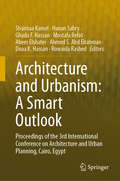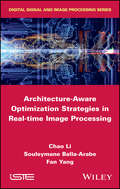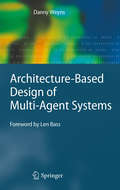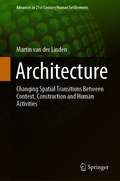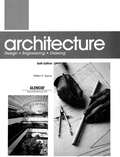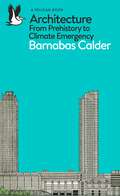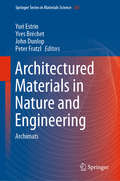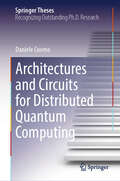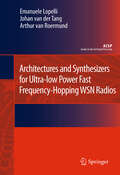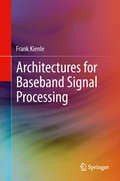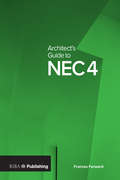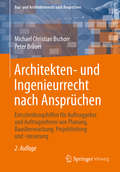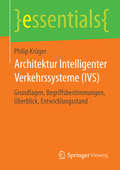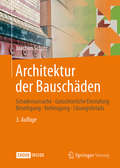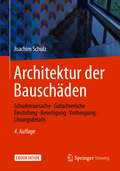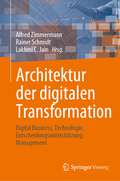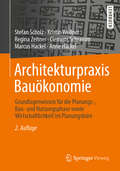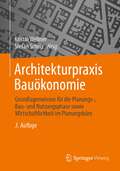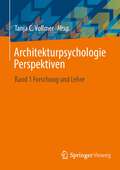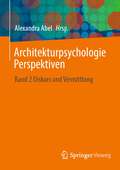- Table View
- List View
Architecture and Principles of Systems Engineering (Complex and Enterprise Systems Engineering)
by Charles Dickerson Dimitri N. MavrisThe rapid evolution of technical capabilities in the systems engineering (SE) community requires constant clarification of how to answer the following questions: What is Systems Architecture? How does it relate to Systems Engineering? What is the role of a Systems Architect? How should Systems Architecture be practiced?A perpetual reassessment of concepts and practices is taking place across various systems disciplines at every level in the SE community. Architecture and Principles of Systems Engineering addresses these integral issues and prepares you for changes that will be occurring for years to come. With their simplified discussion of SE, the authors avoid an overly broad analysis of concepts and terminology. Applying their substantial experience in the academic, government, and commercial R&D sectors, this book is organized into detailed sections on: Foundations of Architecture and Systems Engineering Modeling Languages, Frameworks, and Graphical Tools Using Architecture Models in Systems Analysis and Design Aerospace and Defense Systems Engineering Describing ways to improve methods of reasoning and thinking about architecture and systems, the text integrates concepts, standards, and terminologies that embody emerging model-based approaches but remain rooted in the long-standing practices of engineering, science, and mathematics. With an emphasis on maintaining conceptual integrity in system design, this text describes succinct practical approaches that can be applied to the vast array of issues that readers must resolve on a regular basis. An exploration of the important questions above, this book presents the authors’ invaluable experience and insights regarding the path to the future, based on what they have seen work through the power of model-based approaches to architecture and systems engineering.
Architecture and Urbanism: Proceedings of the 3rd International Conference on Architecture and Urban Planning, Cairo, Egypt
by Shaimaa Kamel Hanan Sabry Ghada F. Hassan Mostafa Refat Abeer Elshater Ahmed S. Abd Elrahman Doaa K. Hassan Rowaida RashedThis proceedings addresses the challenges of urbanization that gravely affect the world’s ecosystems. To become efficiently sustainable and regenerative, buildings and cities need to adopt smart solutions. This book discusses innovations of the built environment while depicting how such practices can transform future buildings and urban areas into places of higher value and quality. The book aims to examine the interrelationship between people, nature and technology, which is essential in pursuing smart environments that optimize human wellbeing, motivation and vitality, as well as promoting cohesive and inclusive societies: Urban Sociology - Community Involvement - Place-making and Cultural Continuity – Environmental Psychology - Smart living - Just City. The book presents exemplary practical experiences that reflect smart strategies, technologies and innovations, by established and emerging professionals, provides a forum of real-life discourse. The primary audience for the work will be from the fields of architecture, urban planning and built-environment systems, including multi-disciplinary academics as well as professionals.
Architecture of Brazil: 1900-1990
by Hugo SegawaArchitecture of Brazil: 1900-1990 examines the processes that underpin modern Brazilian architecture under various influences and characterizes different understandings of modernity, evident in the chapter topics of this book. Accordingly, the author does not give overall preference to particular architects nor works, with the exception of a few specific works and architects, including Warchavchik, Niemeyer, Lucio Costa, and Vilanova Artigas.
Architecture-Aware Optimization Strategies in Real-time Image Processing
by Fan Yang Chao Li Souleymane Balla-ArabeIn the field of image processing, many applications require real-time execution, particularly those in the domains of medicine, robotics and transmission, to name but a few. Recent technological developments have allowed for the integration of more complex algorithms with large data volume into embedded systems, in turn producing a series of new sophisticated electronic architectures at affordable prices. This book performs an in-depth survey on this topic. It is primarily written for those who are familiar with the basics of image processing and want to implement the target processing design using different electronic platforms for computing acceleration. The authors present techniques and approaches, step by step, through illustrative examples. This book is also suitable for electronics/embedded systems engineers who want to consider image processing applications as sufficient imaging algorithm details are given to facilitate their understanding.
Architecture-Based Design of Multi-Agent Systems
by Danny WeynsMulti-agent systems are claimed to be especially suited to the development of software systems that are decentralized, can deal flexibly with dynamic conditions, and are open to system components that come and go. This is why they are used in domains such as manufacturing control, automated vehicles, and e-commerce markets. Danny Weyns' book is organized according to the postulate that "developing multi-agent systems is 95% software engineering and 5% multi-agent systems theory." He presents a software engineering approach for multi-agent systems that is heavily based on software architecture - with, for example, tailored patterns such as "situated agent", "virtual environment", and "selective perception" - and on middleware for distributed coordination - with programming abstractions such as "views" and "roles." Next he shows the feasibility and applicability of this approach with the development of an automated transportation system consisting of a number of automatic guided vehicles transporting loads in an industrial setting. Weyns puts the development of multi-agent systems into a larger perspective with traditional software engineering approaches. With this, he opens up opportunities to exploit the body of knowledge developed in the multi-agent systems community to tackle some of the difficult challenges of modern-day software systems, such as decentralized control, location-awareness, self-adaption, and large-scale. Thus his book is of interest for both researchers and industrial software engineers who develop applications in areas such as distributed control systems and mobile applications where such requirements are of crucial importance.
Architecture: Changing Spatial Transitions Between Context, Construction and Human Activities (Advances in 21st Century Human Settlements)
by Martin van der LindenThe question of what architecture is answered in this book with one sentence: Architecture is space created for human activities. The basic need to find food and water places these activities within a larger spatial field. Humans have learned and found ways to adjust to the various contextual difficulties that they faced as they roamed the earth. Thus rather than adapting, humans have always tried to change the context to their activities. Humanity has looked at the context not merely as a limitation, but rather as a spatial situation filled with opportunities that allows, through intellectual interaction, to change these limitations. Thus humanity has created within the world their own contextual bubble that firmly stands against the larger context it is set in. The key notion of the book is that architecture is space carved out of and against the context and that this process is deterministic.
Architecture: Design, Engineering, Drawing
by William Perkins SpenceDesigned especially for college design courses and drafting classes, the text provides an overview of the planning and design of residential and commercial buildings
Architecture: From Prehistory to Climate Emergency (Pelican Books)
by Barnabas CalderA groundbreaking history of architecture told through the relationship between buildings and energyThe story of architecture is the story of humanity. The buildings we live in, from the humblest pre-historic huts to today's skyscrapers, reveal our priorities and ambitions, our family structures and power structures. And to an extent that hasn't been explored until now, architecture has been shaped in every era by our access to energy, from fire to farming to fossil fuels.In this ground-breaking history of world architecture, Barnabas Calder takes us on a dazzling tour of some of the most astonishing buildings of the past fifteen thousand years, from Uruk, via Ancient Rome and Victorian Liverpool, to China's booming megacities. He reveals how every building - from the Parthenon to the Great Mosque of Damascus to a typical Georgian house - was influenced by the energy available to its architects, and why this matters.Today architecture consumes so much energy that 40% of the world's greenhouse gas emissions come from the construction and running of buildings. If we are to avoid catastrophic climate change then now, more than ever, we need beautiful but also intelligent buildings, and to retrofit - not demolish - those that remain. Both a celebration of human ingenuity and a passionate call for greater sustainability, this is a history of architecture for our times.
Architectured Materials in Nature and Engineering: Archimats (Springer Series in Materials Science #282)
by John Dunlop Yuri Estrin Yves Bréchet Peter FratzlThis book deals with a group of architectured materials. These are hybrid materials in which the constituents (even strongly dissimilar ones) are combined in a given topology and geometry to provide otherwise conflicting properties. The hybridization presented in the book occurs at various levels - from the molecular to the macroscopic (say, sub-centimeter) ones. This monograph represents a collection of programmatic chapters, defining archimats and summarizing the results obtained by using the geometry-inspired materials design. The area of architectured or geometry-inspired materials has reached a certain level of maturity and visibility for a comprehensive presentation in book form. It is written by a group of authors who are active researchers working on various aspects of architectured materials. Through its 14 chapters, the book provides definitions and descriptions of the archetypes of architectured materials and addresses the various techniques in which they can be designed, optimized, and manufactured. It covers a broad realm of archimats, from the ones occurring in nature to those that have been engineered, and discusses a range of their possible applications. The book provides inspiring and scientifically profound, yet entertaining, reading for the materials science community and beyond.
Architectures and Circuits for Distributed Quantum Computing (Springer Theses)
by Daniele CuomoThis thesis treats networks providing quantum computation based on distributed paradigms. Compared to architectures relying on one processor, a network promises to be more scalable and less fault-prone. Developing a distributed system able to provide practical quantum computation comes with numerous challenges, each of which need to be faced with careful analysis in order to create a seamless integration of multiple engineered components.In accordance with hardware technologies, currently under development worldwide, telegates represent the fundamental inter-processor operations. Each telegate consists of several tasks: i) entanglement generation and distribution, ii) local operations, and iii) classical communications. Entanglement generation and distribution is an expensive resource, as it is time-consuming. The primary contribution of this thesis lies in the extensive analysis of some complex scenarios of general interest. We propose numerical models that help to identifythe interdependence between computation and communication. With the support of some of the best tools for reasoning -- i.e. network optimization, circuit manipulation, group theory and ZX-calculus -- we lay out new perspectives on the way a distributed quantum computing system should be developed.
Architectures and Synthesizers for Ultra-low Power Fast Frequency-Hopping WSN Radios (Analog Circuits and Signal Processing)
by Arthur H.M. van Roermund Emanuele Lopelli Johan van der TangWireless sensor networks have the potential to become the third wireless revolution after wireless voice networks in the 80s and wireless data networks in the late 90s. Unfortunately, radio power consumption is still a major bottleneck to the wide adoption of this technology. Different directions have been explored to minimize the radio consumption, but the major drawback of the proposed solutions is a reduced wireless link robustness. The primary goal of Architectures and Synthesizers for Ultra-low Power Fast Frequency-Hopping WSN Radios is to discuss, in detail, existing and new architectural and circuit level solutions for ultra-low power, robust, uni-directional and bi-directional radio links. Architectures and Synthesizers for Ultra-low Power Fast Frequency-Hopping WSN Radios guides the reader through the many system, circuit and technology trade-offs he will be facing in the design of communication systems for wireless sensor networks. Finally, this book, through different examples realized in both advanced CMOS and bipolar technologies opens a new path in the radio design, showing how radio link robustness can be guaranteed by techniques that were previously exclusively used in radio systems for middle or high end applications like Bluetooth and military communications while still minimizing the overall system power consumption.
Architectures for Baseband Signal Processing
by Frank KienleThis book addresses challenges faced by both the algorithm designer and the chip designer, who need to deal with the ongoing increase of algorithmic complexity and required data throughput for today's mobile applications. The focus is on implementation aspects and implementation constraints of individual components that are needed in transceivers for current standards, such as UMTS, LTE, WiMAX and DVB-S2. The application domain is the so called outer receiver, which comprises the channel coding, interleaving stages, modulator, and multiple antenna transmission. Throughout the book, the focus is on advanced algorithms that are actually in use in modern communications systems. Their basic principles are always derived with a focus on the resulting communications and implementation performance. As a result, this book serves as a valuable reference for two, typically disparate audiences in communication systems and hardware design.
Architect’s Guide to NEC4
by Frances ForwardThis user friendly guide introduces, explains, and demystifies the NEC4 contract on a practical, work-based level. Made for architects by an architect, it explores the best approach to collaborative and contractual partnering work practices. Alongside explanations of the contracts and clauses, it presents the key areas of distinction from alternative standard form contracts and examines the integrated project management principles that bring the NEC4 contracts together as a whole. It's the perfect companion book for professionals who are new to the NEC contract family and former users trying to understand the latest updates.
Architekten- und Ingenieurrecht nach Ansprüchen: Entscheidungshilfen für Auftraggeber und Auftragnehmer von Planung, Bauüberwachung, Projektleitung und -steuerung (Bau- und Architektenrecht nach Ansprüchen)
by Michael Christian Bschorr Peter BräuerNach Anspruchsgrundlagen geordnet werden die tatbestandlichen Voraussetzungen aller relevanten Ansprüche von Auftraggebern und Auftragnehmern von Planungs-, Objektüberwachungs-, Projektleistungs- und Projektsteuerungsleistungen dargestellt. Ablaufdiagramme und graphische Erläuterungen bieten dem Leser einen schnellen Überblick und praxisnahe Hilfestellungen. Die vorliegende 2. Auflage berücksichtigt das zum 1. Januar 2018 reformierte Werkvertragsrecht des BGB.
Architektur Intelligenter Verkehrssysteme: Grundlagen, Begriffsbestimmungen, Überblick, Entwicklungsstand (essentials)
by Philip KrügerPhilip Krüger liefert einen Überblick zur Architektur Intelligenter Verkehrssysteme (IVS) und vermittelt wichtige Grundlagen und Entwicklungstrends im Themenfeld. Der Autor beschreibt den Fortschritt in Deutschland zur Erarbeitung einer umfassenden und intermodalen IVS-Architektur und bewertet diesen genauer. Für die koordinierte und harmonisierte Weiterentwicklung von IVS werden Rahmenbedingungen benötigt, wie sie in einer nationalen IVS-Architektur beschrieben sind. Dabei darf eine nationale IVS-Architektur nicht als Hemmnis für Innovationen verstanden werden, sondern vielmehr als Basis jeder systematischen Weiter- und Neuentwicklung von IVS.
Architektur der Bauschäden: Schadensursache - Gutachterliche Einstufung - Beseitigung - Vorbeugung - Lösungsdetails
by Joachim SchulzAnhand von ca. 110 Beispielen, untergliedert nach Bauteilen, werden Planungs- und Ausführungsfehler vorgestellt und wie folgt analysiert: - Schadensursache - gutachterliche Einstufung - Beseitigung - Vorbeugung Nach dem Motto "Bauen ist ein Kampf mit dem Wasser" wird als Schwerpunktthema der Bereich Feuchteschäden an Balkonen, Terrassen, WU-Beton-Kellern, Lichtschächten, Kelleraußentreppen, Rampen usw. behandelt. Da durch mangelhafte Ausführung aus guten Baustoffen oft schlechte Bauteile entstehen, soll der Planer vorbeugend auf mögliche Ausführungsfehler aufmerksam gemacht werden. Die 2. Auflage wurde überarbeitet und um neue aktuelle Beispiele ergänzt.
Architektur der Bauschäden: Schadensursache - Gutachterliche Einstufung - Beseitigung - Vorbeugung - Lösungsdetails
by Joachim SchulzAnhand von ca. 170 Beispielen, mit über 120 Prinzipskizzen, untergliedert nach Bauteilen, werden Planungs- und Ausführungsfehler vorgestellt und wie folgt analysiert: Schadensursache - gutachterliche Einstufung - Beseitigung - Vorbeugung. Nach dem Motto "Bauen ist ein Kampf mit dem Wasser" wird als Schwerpunktthema der Bereich Feuchteschäden an Balkonen, Terrassen, WU-Beton-Kellern, Lichtschächten, Kelleraußentreppen, Rampen usw. behandelt. Da durch mangelhafte Ausführung aus guten Baustoffen oft schlechte Bauteile entstehen, soll der Planer vorbeugend auf mögliche Ausführungsfehler aufmerksam gemacht werden. Die 4. Auflage wurde überarbeitet, aktualisiert und um neue Beispiele und Themenkomplexe ergänzt.
Architektur der Bauschäden: Schadensursache - Gutachterliche Einstufung - Beseitigung - Vorbeugung - Lösungsdetails
by Joachim SchulzAnhand von ca. 110 Beispielen, untergliedert nach Bauteilen, werden Planungs- und Ausführungsfehler vorgestellt und wie folgt analysiert: - Schadensursache - gutachterliche Einstufung - Beseitigung - Vorbeugung Nach dem Motto "Bauen ist ein Kampf mit dem Wasser" wird als Schwerpunktthema der Bereich Feuchteschäden an Balkonen, Terrassen, WU-Beton-Kellern, Lichtschächten, Kelleraußentreppen, Rampen usw. behandelt. Da durch mangelhafte Ausführung aus guten Baustoffen oft schlechte Bauteile entstehen, soll der Planer vorbeugend auf mögliche Ausführungsfehler aufmerksam gemacht werden. Die 2. Auflage wurde überarbeitet und um neue aktuelle Beispiele ergänzt.
Architektur der digitalen Transformation: Digital Business, Technologie, Entscheidungsunterstützung, Management
by Lakhmi C. Jain Rainer Schmidt Alfred ZimmermannDieses forschungsorientierte Buch enthält wichtige Beiträge zur Gestaltung der digitalen Transformation. Es umfasst die folgenden Hauptabschnitte in 20 Kapiteln:- Digitale Transformation- Digitales Geschäft- Digitale Architektur- Entscheidungshilfe- Digitale Anwendungen Es konzentriert sich auf digitale Architekturen für intelligente digitale Produkte und Dienstleistungen und ist eine wertvolle Ressource für Forscher, Doktoranden, Postgraduierte, Absolventen, Studenten, Akademiker und Praktiker, die sich für die digitale Transformation interessieren.
Architekturpraxis Bauökonomie: Grundlagenwissen für die Planungs-, Bau- und Nutzungsphase sowie Wirtschaftlichkeit im Planungsbüro
by Regina Zeitner Stefan Scholz Kristin Wellner Clemens Schramm Marcus Hackel Anne HackelDieses Lehrbuch stellt das komplexe Tätigkeitsfeld des Architekten aus planungs- und bauökonomischer Sicht dar. Die Aufgaben des Architekten werden prozessorientiert im Sinne eines Qualitätsmanagementsystems vermittelt beginnend bei den Kernprozessen der Planung bis zur Realisierung des Bauvorhabens.
Architekturpraxis Bauökonomie: Grundlagenwissen für die Planungs-, Bau- und Nutzungsphase sowie Wirtschaftlichkeit im Planungsbüro
by Stefan Scholz Kristin WellnerDieses Lehrbuch stellt das komplexe Tätigkeitsfeld der Architekt*innen aus planerischer-, bauökonomischer und immobilienwirtschaftlicher Sicht dar. Die Aufgaben des*der Architekt*in werden prozessorientiert im Sinne des Planungs- und Bauprozesses dargestellt. Ein weiteres Thema ist die Wirtschaftlichkeit im Architekturbüro selbst. Das Lehrbuch gibt so – aufbauend auf den Einführungstexten in die Bauökonomie und Immobilienwirtschaft – einen Überblick über alle für die Architekt*innentätigkeit relevanten ökonomischen Inhalte und vertieft die besonders praxisrelevanten Themen ausführlich. Neu in der 3. Auflage: Das Thema Haftung wurde komplett überarbeitet und alle Rechtsthemen aktualisiert. Außerdem wurde Wert auf die übergreifende Einbindung der Bedeutung von Lebenszykluskostenanalyse und Digitalisierung gelegt.
Architekturpsychologie Perspektiven: Band 1 Forschung und Lehre
by Tanja C. VollmerWas können wir aus der Forschung über die Wirkung von Architektur auf Gesundheit und Erleben der Menschen lernen? Wie vermitteln wir die interdisziplinären Erkenntnisse heute und morgen? In diesem Buch wird die Architekturpsychologie als Schlüsselkonzept der gesundheitsbezogenen Evidence Based Design Forschung vorgestellt. Dabei entwickeln renommierte Wissenschaftler:innen aus Deutschland, Dänemark und der Schweiz anhand verständlicher Beispiele ihre Forschungs- und Lehrperspektiven u.a. zum Krankenhaus-, Schul- und Städtebau sowie zum Design. Unterschiede der phänomenologischen, explorativen und empirischen Forschung werden herausgearbeitet sowie hilfreiche Modelle und Konzepte der modernen Architekturpsychologie erklärt. Einleitend wirft der Band einen Blick auf Entstehung und aktuellen Stand der Architekturpsychologie in Deutschland.
Architekturpsychologie Perspektiven: Band 2 Diskurs und Vermittlung
by Alexandra AbelIn der gebauten und vom Menschen beeinflussten Umwelt manifestiert sich unser Leben: Lebenshaltung, Lebensformen, Lebensentwurf. Indem man Architektur neu denkt, hat man daher das Potential, die derzeitige Form unseres Lebens zu überdenken. Ein solches Neu, Anders braucht eine Sensibilisierung für die Relevanz der gebauten Umwelt, für die Werte und Zielgrößen, die hinter einer bestimmten Gestaltung stehen und braucht einen gesamtgesellschaftlichen Diskurs zu der zentralen Frage: Wie wollen wir leben? Wie dürfen wir leben? Vor dem Hintergrund ökologischer und ökonomischer Fairness: Welche Lebensformen sind kompatibel mit einer möglichst hohen Lebensqualität für uns alle, als Teil eines Ökosystems, mit dem unser Wohlbefinden unauflöslich verbunden ist. In diesem Band kommen namhafte Expertinnen aus Österreich, der Schweiz und Deutschland aus den Disziplinen der Architektur, der Psychologie, der Kunst und Kunstdidaktik zu Wort, die sich zu der Relevanz und zu den Voraussetzungen einer solchen Debatte äußern.
Architekturpsychologie Perspektiven: Band 3 Entwurf und Prozess
by Martina GuhlWie findet die Begegnung von Psychologie und Architektur während des Entwurfs- und Planungsprozesses statt? In welchem Planungsabschnitt wird architekturpsychologisches Wissen relevant und einsetzbar? Welche Erkenntnisse liefert die urbane Architekturpsychologie für den städtebaulichen Diskurs? In diesem Buch bringen renommierte Expert*innen aus Deutschland, der Niederlande und der Schweiz aus den Disziplinen Architektur, Psychologie, Städtebau, Farbgestaltung und Kommunikationspsychologie ihr Pionierwissen ein.
Archiving Strategies for Evolutionary Multi-objective Optimization Algorithms (Studies in Computational Intelligence #938)
by Carlos Hernández Oliver SchützeThis book presents an overview of archiving strategies developed over the last years by the authors that deal with suitable approximations of the sets of optimal and nearly optimal solutions of multi-objective optimization problems by means of stochastic search algorithms. All presented archivers are analyzed with respect to the approximation qualities of the limit archives that they generate and the upper bounds of the archive sizes. The convergence analysis will be done using a very broad framework that involves all existing stochastic search algorithms and that will only use minimal assumptions on the process to generate new candidate solutions. All of the presented archivers can effortlessly be coupled with any set-based multi-objective search algorithm such as multi-objective evolutionary algorithms, and the resulting hybrid method takes over the convergence properties of the chosen archiver. This book hence targets at all algorithm designers and practitioners in the field of multi-objective optimization.

